Getting to Know the Anna’s Hummingbird
By Taylor Crisologo
I’ve always been captivated by the bright allure of hummingbirds. Their beautiful, iridescent feathers and busy demeanors have made them some of my favorite birds to watch. I was even more impressed by hummingbirds when I learned that all hummingbird species are only found in North and South America. This discovery made me feel that much luckier to know this bird, as they are a treasure only found in the New World.
As a Bay Area native, the Anna’s Hummingbird in particular holds a soft spot in my birding heart. Anna’s Hummingbirds are permanent residents along the west coast of the United States, meaning that our winters in the Bay Area (although very mild to begin with!) are made that much brighter by the presence of the Anna’s Hummingbird. They are also the most common hummingbird on the west coast, making them a universal part of the Bay Area birding experience.
Anna’s Hummingbirds are a frequent and feisty visitor to my hummingbird feeders, and I’ve often watched territorial individuals perch on a branch nearby the food and chase away any unwelcome visitors. When they’re not feeding on my pre-mixed hummingbird food, I find them visiting the mosaic of native and non-invasive plants in my garden.
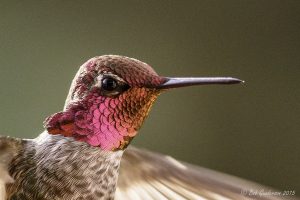
The Anna’s Hummingbird’s ability to make use of some exotic plants found in urban and suburban areas, as well as supplemental sources of food from hummingbird feeders, have allowed them to
greatly expand their range. While the species once only nested in certain areas of California and Baja California, you can now see this brilliant bird almost everywhere in California and well into the Southwest and British Columbia.
Rain brings more hummingbird food, namely nectar-producing plants and insects, which is perfect for breeding hummingbirds. Thus, Anna’s Hummingbirds will breed in the winter and
early spring, timing their nesting season with the rainy season in California. This makes them California’s true winter birds, as some individuals have been recorded breeding in the Bay Area during the annual Christmas Bird Count.
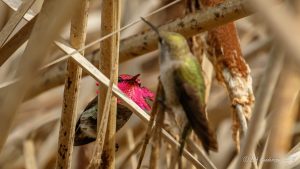
The courtship behavior of breeding Anna’s Hummingbirds is a sight to see. Males will sing energetically to females and begin an ascent up to 130 feet in the air. Then, the males will dive down towards the female, generating a loud, non-vocal “squeak” sound as air vibrates through modified outer tail feathers. Successful males get to mate with females, but the female alone will raise their young – a breeding system familiar to all hummingbird species.
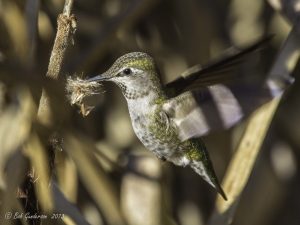
Females will build tiny cup nests constructed of soft plant material and spiderwebs. Their nests measure 1.5 inches in diameter and 1 inch in height. Delicately woven and decorated with moss
or other fine objects, their nests are an amazing construction. The deeper genius of using spider webs as the binding material is revealed as the chicks begin to grow. The nest will stretch keeping the nestlings warm and snug until they are ready to fledge. Females lay 2 eggs, which hatch after 16 days of incubation.
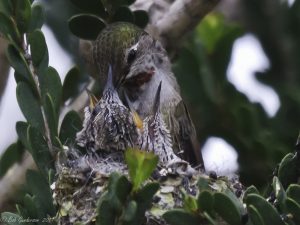
To see more of these vibrant birds in your own backyard, you can try putting up hummingbird feeders mixed with 1 part sugar dissolved in 4 parts water. Better still, plant native flowering plants that will attract and sustain hummingbirds, such as California Fuschia. Chances are that you’ll soon have bright and busy visitors, and endless opportunity to watch this interesting and iconic species.
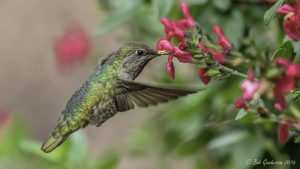
Taylor Crisologo lives in the South Bay, where she avidly birds and runs a site on Bay Area nature (www.bayareanaturalist.com). She studied biology at Cornell University, where she
worked with the Cornell Lab of Ornithology on projects ranging from breeding herring gulls off the coast of Maine to dancing lyrebirds in Australia’s Blue Mountains.
